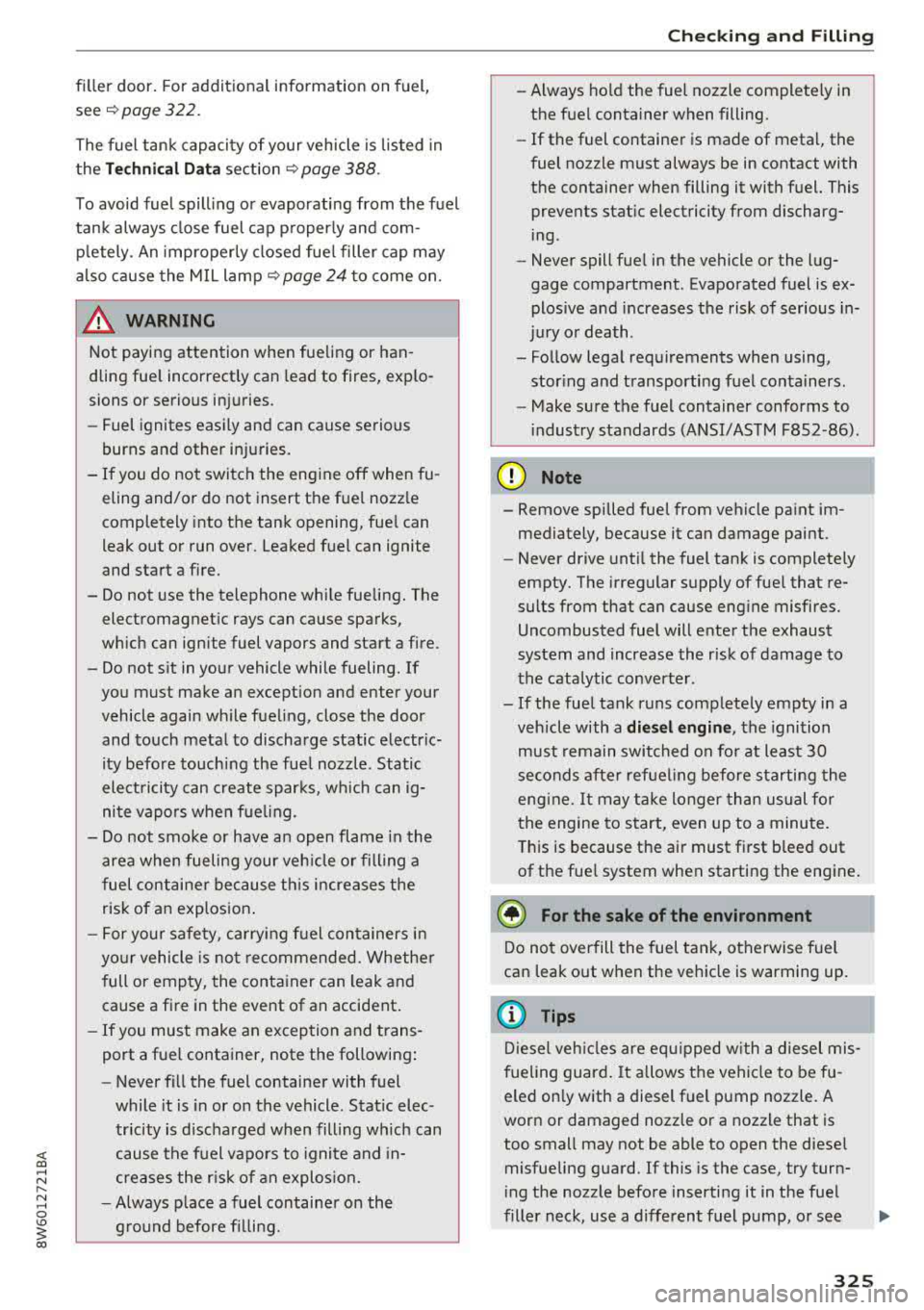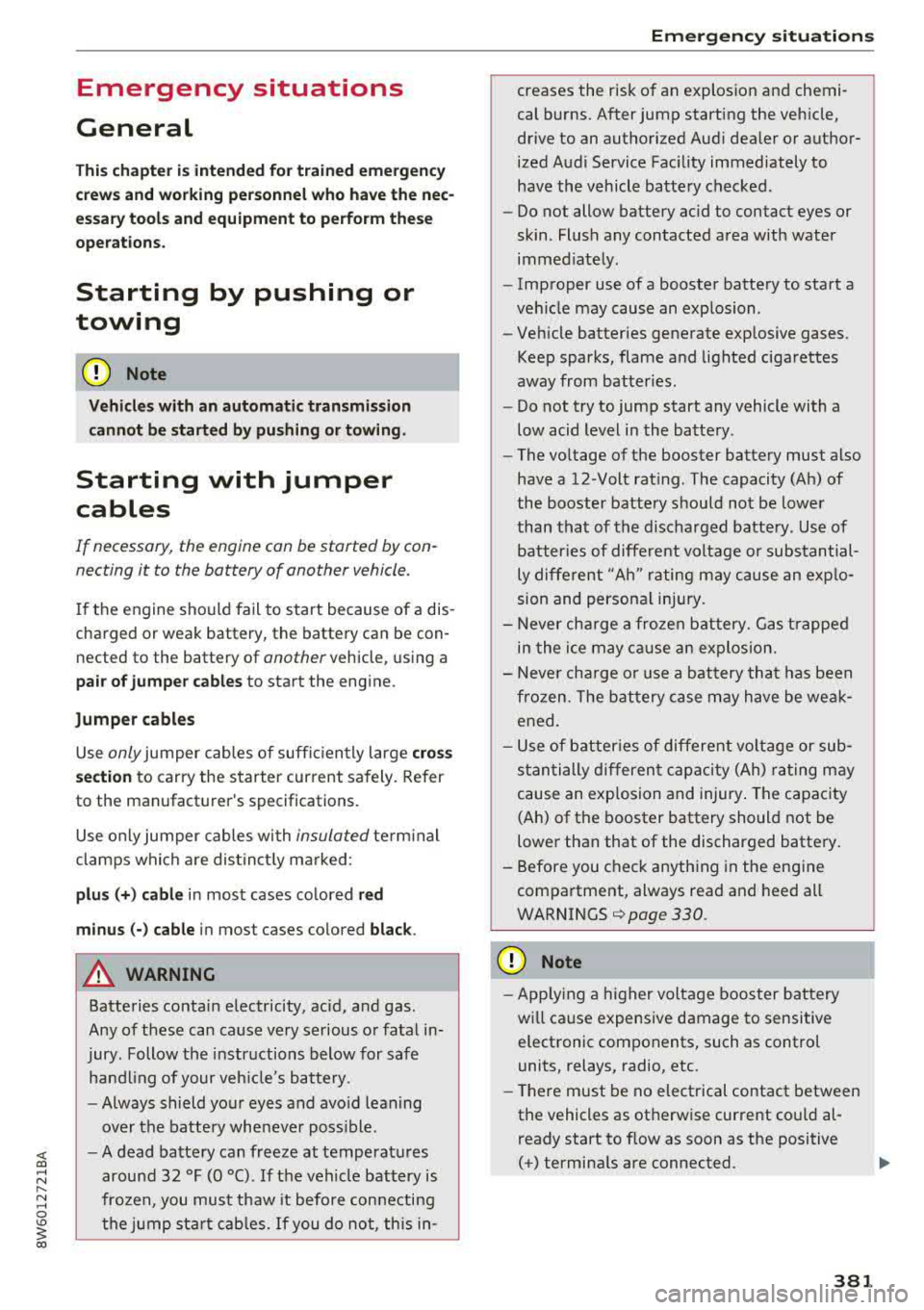Spark AUDI A5 COUPE 2018 Owners Manual
[x] Cancel search | Manufacturer: AUDI, Model Year: 2018, Model line: A5 COUPE, Model: AUDI A5 COUPE 2018Pages: 409, PDF Size: 67.63 MB
Page 326 of 409

<( a, .... N ,....
N .... 0 \0
3 a,
filler door. For additional information on fuel,
see
~page 322.
The fuel tank capacity of your vehicle is listed in the
T ec hnical Dat a section ~ page 388.
To avoid fuel spill ing or evaporating from the fuel
tank always close fuel cap p roperly and com
p letely . An improperly closed fue l filler cap may
a lso cause the MIL
lamp~ page 24 t o come on.
A WARNING -
Not paying attention when fueling or han
dling fue l incorrectly can lead to fires, exp lo
sions or serious in juries.
-Fuel ignites easily and can cause serious
burns and other injuries.
-If you do not switch the engine off when fu
eling and/or do not insert the fuel nozz le
completely into the tank opening, fue l can
leak out or run over. Leaked fuel can ignite
and start a fire.
-Do not use the telephone whi le fueling. The
electromagnetic rays can cause sparks,
wh ich can ignite fuel vapors and start a fire.
-Do not sit in your vehicle while fueling. If
you must make an except ion and enter your
vehicle again wh ile fue ling, close the door
and touch meta l to discharge static electric
ity befo re touch ing the fue l nozzle. Static
elect ricity can create spar ks, wh ich can ig
ni te vapo rs when fue ling.
-Do not smoke or have an open flame in the
area when fueling your veh icle o r filling a
f uel contai ner because th is increases the
risk of an explos ion .
-For yo ur safety, carrying f uel containers in
yo ur vehicle is no t recommended. Whethe r
f ull or empty, the conta iner can leak a nd
cause a fire in the event of an accident .
-If you must make an exception and trans
port a fuel container, note the following :
-Never fill the fuel container with fuel
while it is in or on the vehicle. Stat ic elec
tr icity is d ischa rged when filling wh ich can
cause the f uel vapors to ignite and in
creases the r isk of an explos ion.
-Always p lace a fuel containe r on the
g ro u nd before fi llin g.
Ch eck ing and Filling
-Always hold the fue l nozzle completely in
the fuel container when filling.
-If the fuel container is made of metal, the
fuel nozzle must always be in contact with
the container when filling it with fuel. This
prevents stat ic electricity from discharg
ing .
-Never spill fuel in the vehicle or the lug
gage compartment. Evaporated fuel is ex
plosive and increases the risk of serious in
jury or death .
-Follow legal requirements when using,
stor ing and transporti ng fuel conta iners .
-Make sure the fuel container conforms to
industry standards (ANSI/AS TM F8S2-86).
@ Note
-Remove spilled fuel from vehicle pa int im
mediately, because it can damage paint.
-Never drive unti l the fuel tank is complete ly
empty. The irregular supply of fue l that re
sults from that can cause eng ine misfires.
Uncombusted fuel will enter the exhaust
system and increase the risk of damage to
t he catalytic converte r.
-If the fue l tank runs complete ly empty in a
vehicle with a
diesel eng ine , the ignition
must remain swit ched on fo r at least 30
se conds afte r ref ueli ng before starti ng the
eng ine. It may take longer than usual fo r
t he engine to s tart, even up to a minu te.
T his is because the air must first b leed out
of the fue l system when starting the eng ine.
@ For the sake of the environment
Do not overfill the fuel tank, otherwise fuel
can leak out when the veh icle is warming up.
(D Tips
D iesel ve hicles are eq uipped w ith a diesel mis
fueling guard .
It allows the vehi cle to be fu
eled on ly with a diesel fuel pump nozzle. A
worn or damaged nozzle or a nozzle that is
too small may not be able to open the diese l
misfueling guard. If this is the case, try turn
i ng the nozzle before inserting it in the fue l
filler neck, use a different fuel pump, o r see
325
Page 382 of 409

<( a, .... N ,....
N .... 0 \0
3 a,
Emergency situations
General
This chapter is intended for trained emergency
crews and working personnel who have the nec
essary tools and equipment to perform these
operations.
Starting by pushing or
towing
CD Note
Vehicles with an automatic transmission
cannot be started by pushing or towing.
Starting with jumper
cables
If necessary, the engine can be started by con
necting it to the battery of another vehicle.
If the engine should fail to start because of a dis
charged or weak battery, the battery can be con
nected to the battery of
another vehicle, using a
pair of jumper cables to start the engine.
Jumper cables
Use only jumper cables of sufficiently large cross
section
to carry the starter current safely. Refer
to the manufacturer's specifications.
Use only jumper cables with
insulated terminal
clamps which are distinctly marked:
plus(+) cable in most cases colored red
minus(·) cable
in most cases colored black.
A WARNING
Batteries contain electricity, acid, and gas.
Any of these can cause very serious or fatal in
jury. Follow the instructions below for safe
handling of your vehicle's battery.
-Always shield your eyes and avoid leaning
over the battery whenever possible.
-A dead battery can freeze at temperatures
around 32 °F (0 °C). If the vehicle battery is
frozen, you must thaw it before connecting
the jump start cables. If you do not, this in-
Emergency situations
creases the risk of an explosion and chemi
cal burns. After jump starting the vehicle,
drive to an authorized Audi dealer or author ized Audi Service Facility immediately to
have the vehicle battery checked.
- Do not allow battery acid to contact eyes or
skin . Flush any contacted area with water
immediately.
- Improper use of a booster battery to start a
vehicle may cause an explosion .
- Vehicle batteries generate explosive gases.
Keep sparks, flame and lighted cigarettes
away from batteries.
- Do not try to jump start any vehicle with a
low acid level in the battery .
- The voltage of the booster battery must also
have a 12-Volt rating. The capacity (Ah) of
the booster battery should not be lower
than that of the discharged battery. Use of
batteries of different voltage or substantial
ly different
"A h" rating may cause an explo
sion and personal injury.
- Never charge a frozen battery. Gas trapped
in the ice may cause an explosion.
- Never charge or use a battery that has been
frozen . The battery case may have be weak
ened.
- Use of batteries of different voltage or sub
stantially different capacity (Ah) rating may
cause an explosion and injury. The capacity (Ah) of the booster battery should not be
lower than that of the discharged battery.
- Before you check anything in the engine
compartment, always read and heed all
WARNINGS
qpage 330.
CD Note
- Applying a higher voltage booster battery
will cause expensive damage to sensitive electronic components, such as control
units, relays, radio, etc.
- There must be no electrical contact between
the vehicles as otherwise current could al
ready start to flow as soon as the positive
(+) terminals are connected.
381
Page 387 of 409

Technical data
Technical data
Vehicle specifications
Fig. 309 Windshiel d (fro nt left) : Ve hicl e Iden tific ation
N um ber ( VIN )
XXXXX XX -X -XXXX XXX XX
@-+ ~J:~t::1 ::: xxxxxxxx xx x xxxxxxxx
I YP lf'VPE XXX XXX
XX XXXXXXX XX X X XX
XXX
KW XXX
15\_L I MOIOlll
@-+ ~~
1
:tr:~i XXXX I XXXX XXX I XX
II. -AUSST . / OPTIONS
.__ __
E0A 7D5 4UB
2EH JOZ lLB
3FC
F0 A 9G3
TL6 3 KA 8EH
lXW 803
7T6 CV7 7KO
3L4 4KC
lS A 7GB
6XM SSG
lAS
SMU 7Xl
0G7 0YH
UlA X9B
908 8Z4
4X3 2K2
3Y0 413
01A
SRW
1BA
OJF
027
020
502
4G0
XX X XX X XX X XXXX
Fig. 310 Vehi cle identification label
Vehicle Identification Number (VIN) in the
Infotainment system
~ Select in the Infotainment system: the I MENU I
button > Vehicle > left contro l button > Service
& checks> Vehicle information.
Vehicle Identification Number (VIN)
The VIN can be found in the Infotainment sys
tem, on the vehicle data label, and under the
windshield on the front left side* <=:>
fig. 309. The
VIN is also in the right side of the luggage com
partme nt.
386
Vehicle identification label
The vehicle identification label <=:> fig. 310 is locat
ed in the luggage compartment under the cargo
floor cover.
The information of the vehicle identification label
can also be found in your Warranty
& Mainte
nance booklet.
The st icker contains the follow ing vehicle data:
(D Vehicle Iden tifica tion Number (VIN)
@ Vehicle type, eng ine output, transmission
® Engine and transmission cod es
@ Paint and interior codes
® Optional equipment numbers
Safety compliance sticker
The safety compliance sticker is your assurance
that your new veh icle complies with all applicable
Federal Motor Vehicle Safety Standards which
were in effect at the time the vehicle was manu
factured. You can find this sticker on the front
e nd of the dr iver's door. It shows the month and
y ear of production and the vehicle identification
number of you r vehicle (perforation) as well as
the G ros s Vehicle Weight R ating (GVWR) and the
Gro ss Axle We ight Rating (GAWR).
H igh voltage warning label
The high voltage warn ing label is located in the
e ngine compartment next to the engine hood re
lease. The spark ignit ion system complies w ith
the Canadian s tand ard IC ES-002.
Notes about technical
data
The values may vary based on special equipment
as well as market-specific equipment and meas u ring methods.
Please note that the specifications listed in the
vehicle documentation a lways take precedence .
(D Tips
Missing technical data was not available at
the time of printing .